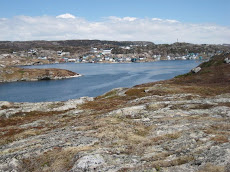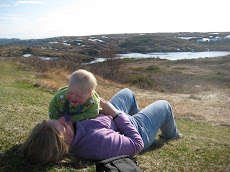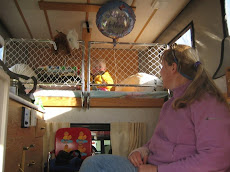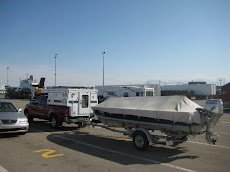…At least, that is how it feels. I know that there are birds out there. All of the literature on birding in Newfoundland say so. My friends that come here to go birding tell me so. Memorial University of Newfoundland professor Bill Montevecchi talks of some impressive sightings. But I am just not finding all that many birds. Granted, trying to bird-watch from Anouk’s fourth floor hospital room complicated things somewhat during her five-week stay, although I did manage to see a Cooper’s Hawk one fine afternoon. Now we are out and I am trying to make up for lost time.
We went from winter to summer in a blink of an eye. I know the birds should be here, but where are they? What I mean to say is that I expected to be identifying a LOT more birds than I am. Back home in Maine, as we were preparing for this trip, I made a bird-list of all the species I thought I was likely to see. Then I made a list of the species I thought I might see with a little work. And, of course, I made a list of those species I could see if I am really lucky. They totaled 200 species! Well, we are two months into our Newfoundland adventure and I have just barely reached 80.
In terms of birds, it has not been quite so dreary as I may have made it out to be. So far there have been a few surprises. As we drove off the ferry in Channel-Port aux Basques, several Bonaparte’s Gulls were mixed in with some Black-headed Gulls. Our first night in Rose Blanche saw a small flock of Snow Geese fly overhead. In the Codroy Valley we found one, then two, then three, then seven Great Blue Herons, a species that until recently was largely unheard of on the island of Newfoundland. A Tennessee Warbler was both early, and the only one we have identified so far this trip. And an American Bittern on Long Pond in St. John’s was an unexpected bonus.
Then there are some observations that just don’t fit in with my previous experiences. In Pippy Park, the campground we stay at within the city limits of St. John’s, Boreal Chickadee is the common bird (I have always had to work hard to find them on the coast of Maine and in the Adirondacks). As their name implies, they like boreal forests…that is, the forests of the north, which is exactly what we have in Newfoundland. What is even stranger is seeing European Starlings and House Sparrows right alongside the Boreal Chickadees…or, at least, within a few meters of each other.
Some expected (but still welcomed) sightings include:
– Northern Gannets plunge-diving for their fishy food close in to shore.
– Atlantic Puffins flying so close I could catch them with a puffin net (think butterfly net but a LOT bigger) in Bonavista.
– Running on the Grand Concourse between the Fluvarium and Quidi Vidi Lake, seeing the bat-like flight of a Common Nighthawk, doubting it because they are quite rare in Newfoundland, and then seeing on the Internet that one was seen near where I saw it.
– Walking with Lindsey Russel to see his garden and having a pair of Whimbrels fly over (I think both of us were as tickled as the other to see these birds).
– Bumping into birders in the Codroy Valley who were out for a bird-a-thon, then getting invited to their barbeque that evening.
– Seeing many Iceland and Glaucous Gulls…far more than the scattered one or two I see each winter in Maine and the Adirondacks.
– Having a very cooperative Lesser Yellowlegs next to a Greater Yellowlegs so I could readily see the differences.
– Being on the unnamed-in-order-to-protect-the-guilty tour boat out of St. John’s, seeing colonies of thousands of cliff-nesting Black-legged Kittiwakes (I managed to ignore the erroneous narration by the captain who said they were the world’s smallest gull). Natalie, Anouk, and I may have been the only ones to see the lone puffin that trip, too.
For anyone that may be interested, here is my bird-list to date:
May 8th (Rose Blanche) – Snow Goose, Bald Eagle, Greater Yellowlegs, Black-headed Gull, Bonaparte’s Gull, Herring Gull, Great Black-backed Gull, Belted Kingfisher, Common Raven, Ruby-crowned Kinglet, Hermit Thrush, American Robin, Savannah Sparrow, Song Sparrow, white-throated Sparrow, Dark-eyed Junco, Common Grackle, House Sparrow
May 9th (Codroy Valley) – Great Cormorant, Chimeny Swift, Blue Jay, American Crow, Black-capped Chickadee, Red-breasted Nuthatch, Yellow-rumped Warbler
May 10th (Codroy Valley) – Canada Goose, Wood Duck, American Wigeon, American Black Duck, Mallard, Blue-winged Teal, Green-winged Teal, Common Merganser, Red-breasted Merganser, Ruffed Grouse, Great Blue Heron, Osprey, Northern Harrier, Merlin, Wilson’s Snipe, Northern Flicker, Tree Swallow, Barn Swallow, Tennessee Warbler, American Goldfinch
May 11th (Stephenville) – Ring-necked Duck, Northern Gannet, Iceland Gull, Black Guillemot, Rock Pigeon, European Starling, Pine Siskin
May 12th (Stephenville) – Greater Scaup, Ring-billed Gull
May 13th (Stephenville) – Purple Finch
May 14th (Stephenville) – Double-crested Cormorant, Glaucous Gull
May 17th (Come By Chance) – Common Loon, Lesser Yellowlegs, Golden-crowned Kinglet, Evening Grosbeak
May 18th (Come By Chance) – Arctic Tern
May 20th (St. John’s) – Boreal Chickadee
May 22nd (St. John’s) – Northern Pintail
May 23rd (St. John’s) – Red Crossbill
May 27th (St. John’s) – Yellow Warbler
May 29th (St. John’s) – American Bittern
May 31st (St. John’s) – White-winged Crossbill
June 4th (St. John’s) – Cooper’s Hawk, Common Tern
June 5th (St. John’s) – Black-legged Kittiwake, White-crowned Sparrow
June 8th (St. John’s) – Cedar Waxwing, Magnolia Warbler
June 12th (St. John’s) – Great Horned Owl
June 13th (St. John’s) – Killdeer
June 15th (St. John’s) – Common Nighthawk, Nashville Warbler, Blackpoll Warbler
June 28th (St. John’s) – Mourning Warbler
June 29th (St. John’s) – Surf Scoter
July 1st (Bonavista) – Whimbrel
Total: 82 species
Saturday, July 05, 2008
Birding in a birdless land…
Subscribe to:
Post Comments (Atom)



































No comments:
Post a Comment